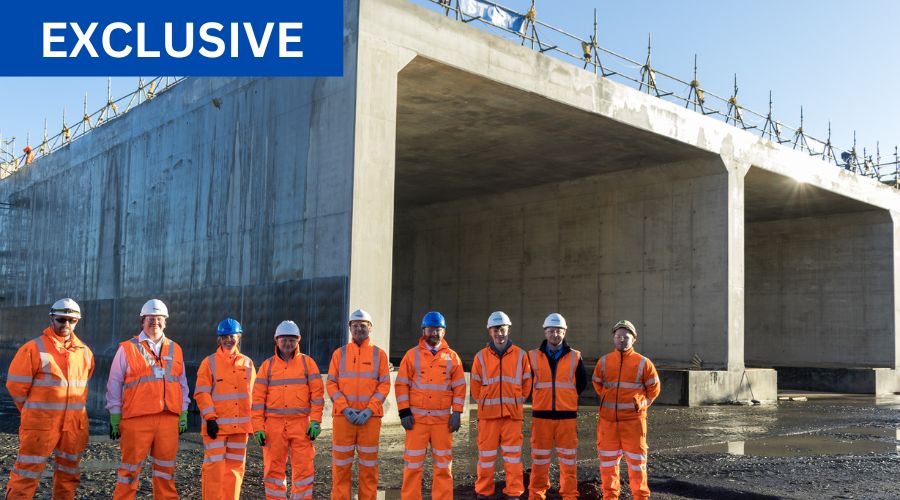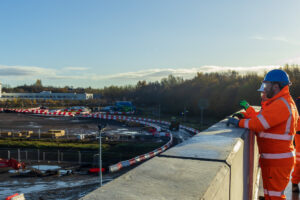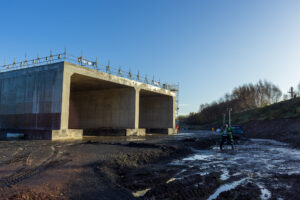‘How did they do that?’. Often this is the first question whenever I’m confronted with any seemingly impossible feat of C&E ingenuity (and believe me, it’s a lot!).

by Rory Butler / January 4, 2023
The brow knitting, lip pursing and forehead slapping ensues as I stand before the latest industry marvel, trying to solve this very riddle.
Imagine, then, the facial contortions and mental acrobatics when I learned Story Contracting and Network Rail planned to move the ‘largest concrete bridge in the UK’ in the Spring.
How? Why? With what – and whom? And when?
The signal went up, and in a flash, a dynamic duo appeared.
David Hamilton (Story) and Mark Wilson (Network Rail) are Project Managers for this ambitious venture in North Lanarkshire.
The £16.9 million deal will see construction of a new bridge to carry the West Coast Main Line over a new dual carriageway between Motherwell and Ravenscraig.
 Both aspects are the first stage of the £127.2 million Ravenscraig Access Infrastructure (RAI) project, supported by £61.9 million from the Glasgow City Region City Deal – and are part of ongoing regeneration work at the Ravenscraig former steelworks.
Both aspects are the first stage of the £127.2 million Ravenscraig Access Infrastructure (RAI) project, supported by £61.9 million from the Glasgow City Region City Deal – and are part of ongoing regeneration work at the Ravenscraig former steelworks.
Hamilton and Wilson explain the technology, processes (on and offline), logistics, innovation and delivery team behind the project – and importantly, the benefits of this approach.
How do self-propelled modular transporters (SPMTs) work?
“SPMTs are an industry leading method for heavy load transport. They use a hydraulic Power Pack Unit (PPU) which provides power for lifting, driving and steering. Using wireless-controlled axles and power packs provides a specialist transport solution that is flexible and increases manoeuvrability on site. Available in various axle units, they can be operated independently, or they can be hydraulically and electronically linked to be configured into any combination.
“A typical SPMT has a grid of computer-controlled axles, usually two axles across and between four and eight axles long. When two (or more) axles are placed in series, this is called an ‘axle line’. All axles are individually controllable to evenly distribute weight and to steer accurately. Each axle can swivel through 270°, with some manufacturers offering up to a full 360° of motion. The axles are coordinated by the control system to allow the SPMT to turn, move sideways or even rotate in place. Some SPMTs allow the axles to telescope independently of each other, so that the load can be kept flat and evenly distributed while moving over uneven terrain. Each axle can also contain a hydrostatic drive unit.
“A hydraulic power pack can be attached to the SPMT to provide power for steering, suspension and drive functions. This power pack is driven by an internal combustion engine. A single power pack can drive a string of SPMTs. As SPMTs often carry the world’s heaviest loads on wheeled vehicles, they are very slow, often moving at under one mile per hour (1.6 km/h) while fully loaded. Some SPMTs are controlled by a worker with a hand-held control panel, while others have a driver cabin. Multiple SPMTs can be linked (lengthwise and side-by-side) to transport massive building-sized objects. The linked SPMTs can be controlled from a single control panel.”
Why are SPMTs preferable to move the bridge?
“The use of SPMTs is preferable due to the size and weight of the new structure and the time taken to construct. The SPMTs allow for the structure to be constructed offline before being installed. This ultimately reduces the amount of time required to disrupt traffic on the railway and minimises the subsequent impact on our rail customers. If the structure was to be constructed in situ, a closure of the West Coast Main Line would have been required for months.
“Another benefit of the SPMT method, as opposed to relying on traditional craneage methods, is that the full structure can be constructed offline and eliminates the requirement of sectional installation utilising multiple onerous crane lifts.”
Tell us more about offline construction
“The installation works have not yet taken place – this is planned for Spring when the main SPMT move will take place. The project recently reached a key milestone with the completion of offline construction of the new reinforced concrete portal structure, which will be installed in one section with an approximate weight of 5,000 tonnes.
 “The offline construction of the associated structure wingwalls is ongoing and these will be installed during the core delivery shift using cranes – the heaviest wingwall unit weighs approximately 70 tonnes.”
“The offline construction of the associated structure wingwalls is ongoing and these will be installed during the core delivery shift using cranes – the heaviest wingwall unit weighs approximately 70 tonnes.”
“The construction of the new bridge is ongoing – following site clearance works a casting yard was created for the offsite construction of the main twin portal structure and 18 wingwall units. These are all being cast using traditional steel reinforced concrete methods with temporary works for associated formwork and propping. The concrete was placed using concrete pumps with the main deck poured in two stages – each of the deck pours with an approximate volume of 450 cubic metres.”
Load bearing and life capacity
“The bridge is designed to accommodate railway loading in line with the requirements of Eurocode Design standards and the railway loading model – LM71. The reinforced concrete is designed in accordance with Eurocodes to have a design life of 120 years.”
On the job:
- Aecom – Structure Design
- MHB Consultants – Temporary Works Design
- PBH Rail – Track and Overhead Line Design
- SARENS – SPMT Specialists
- Murform – Reinforced Concrete
- Vital Projects – Track Works
- REL – Overhead Line Works
- Waitings – Earthworks
If you enjoyed this article, we also recommend How Story moved the ‘Largest Concrete Bridge in the UK’
